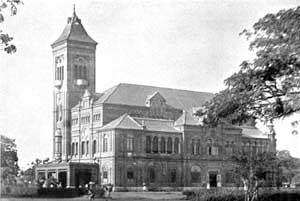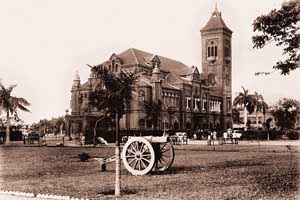|
With work underway on restoring the Victoria Public Hall aka the Town Hall, we look at two views of what the building used to look like about 90-100 years ago. Willie Burke’s picture is featured above and shows one view of the building, while the picture to its right from the Vintage Vignettes’ collection more evocatively shows the spacious surrounding the Hall was once located in.

Willie Burke’s view of the Victoria Public Hall c.1900

The Vintage Vignettes view c.1915
|
The Hall owes its origin to a decision to honour Queen Victoria on her Golden Jubilee in 1887. It was agreed that two buildings be constructed in her name. One was Victoria Public Hall, a civic token of regard planned to be built by public subscription. Robert Chisholm, selected to construct the building, chose the Indo Saracenic style favoured in the official Madras of the day but with the Travancorean elements replacing domes, a style he had begun to favour after designing the Napier Museum building in Trivandrum. The builder was Namberumal Chetty.
The Hall when it came up owed its existence to the drive of Sir A.T. Arundel, President of the Corporation at the time and later a member of the Viceroy’s Council. Arundel, who conceived this form of affirmation of loyalty to the Crown on Queen Victoria’s Jubilee, ensured that adequate funds were raised and saw to it that the Hall was opened in 1887 by Lord Connemara, the Governor, who celebrated his new barony simultaneously. But Arundel’s work would have been the harder if it had not been for the generosity and enthusiasm of Rajah Sir Ananda Gajapati, the Maharajah of Vizianagaram. To build the Hall, 3½ acres (57 grounds) from People’s Park acreage were granted to a Board of Trustees on a 99-year lease at 8 annas (half a rupee) a ground per year!
The Hall was once rented out for public and private meetings, public lectures, stage performances, theatrical and otherwise, balls at a time when ballroom dancing was popular, and other entertainments. It was also meant for “many other purposes conducing to the moral, social and intellectual welfare, or rational recreation of the public of Madras.” All this led to the Hall becoming better known as the Town Hall.
The interior of the Hall is decidedly gaslight Victorian and in its run-down condition in the first quarter of the 21st Century it indeed seemed like “a sleazy strip-joint”, as a ‘Magazine
of Madras’ described it in the 1980s. By the time restorations got underway this year, it had become even more decrepit, despite being presided over from high on by Queen victoria’s stage presence, but its restoration gives it reason to dream of possible glory again as a badly-needed theatre. Once, it seated 600 in the lower hall, 600 in the upper hall and 200 in the balcony. Rentals in the early 1900s ranged from Rs. 3-8-0 to Rs. 40 per night depending on room and usage.
Succeeding to occupancy of VPH in 1939 after the Suguna Vilas Sabha, founded in 1891 by Pammal Sambanda Mudaliar as a pioneer of modern Tamil
theatre, moved to Mount Road, was the Chennapuri Andhra Mahasabha, founded in George Town in 1914 by Sir P. Thyagaraya Chetty. Its aim was to promote Telugu culture and literature, which it successfully did in the 30-odd years it was in the Town Hall. But it also did much for Billiards, Chess and Table Tennis in the city and, between 1948 and 1952, helped found the District Associations for these games in its premises. In 1966, it moved to its own premises built in VPH property and neighbouring the Hall. The Mahasabha’s place was occupied by the South Indian Athletic Association after it vacated its nearby Moore Pavilion.
|